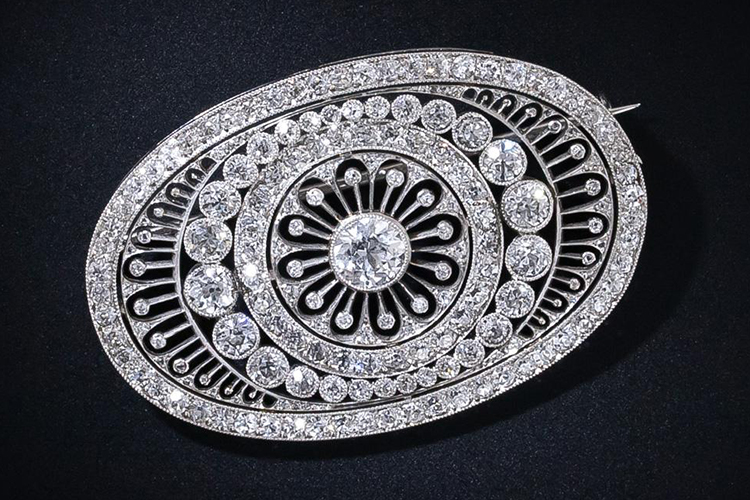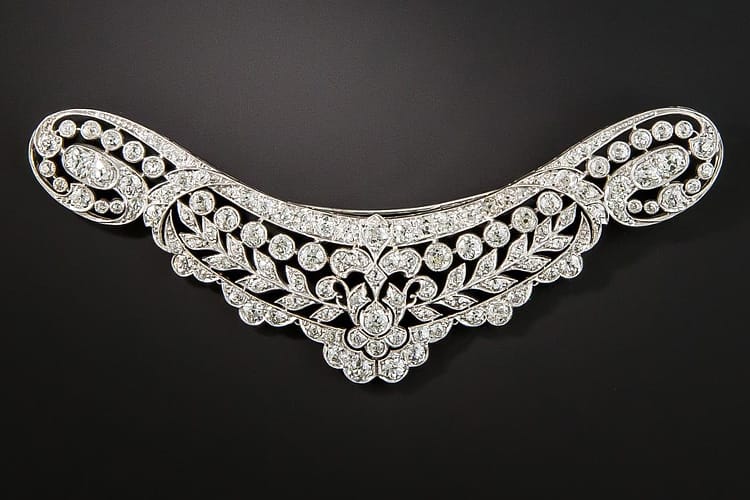How to Identify Edwardian Jewelry

Fashion of the Edwardian Era
The short reign of King Edward VII (1901 to 1910), his court, his sporting lifestyle and his wife Alexandra of Denmark were a breath of fresh air to fashion at the close of the 1800s. Jewelry motifs changed accordingly, with intricate and gracefully symmetrical, diamond-encrusted and lacy designs adorning the neckline, chiffon gowns and the ‘up-do’ hair styles of the well-to-do. Delicate scrolls, leaves, ribbon bows, hearts, circles, swooping swags (or garlands as they were later called), and veil-like twinkling jewelry complimented a new sophisticated style.
To me, Edwardian designs look like a frozen moment – curled in movement, shimmering, draping, scrolling, swaging, circling – just waiting to be worn and move again. The Edwardian femininity, fluidity, and fineness are unmistakeable. Iconic pieces have hinges, dangles, swags, articulation, and tiny swinging gemstone droplets evoking a liquidity and liveliness.
Queen Alexandra loved the uncomfortable but fashionable ‘dog collar’ plaque style necklace, often backed by black velvet. The style transitioned into a column of 6-16 rows of pearls — a challenge to wear for sure. Changing dress necklines brought changing neck ornamentation. A good example is the rivière necklace – a neck-encircling strand of graduating, millegraine-edged, bezel set diamonds — sometimes worn as two bracelets.
We see up to 72-inch long strands of ‘spectacle set’ diamonds, a minimalist technique where only a thin wire wraps the diamond girdle and small side jump rings attach to the next gem. The lavaliere is an articulating drop suspended from a matching design element and attached directly to a thin, fancy link chain. The negligee necklace has two drops, often on different lengths of chain, attached to one design element and a simple chain. Basic pendants have diamond-set, double side engraved, tapered bales that hang on thin, intricately designed chains.
Tiaras of the Edwardian Era
The Edwardian era also saw a fascination with tiaras. Bandeaus, like tiaras, could double as necklaces or bracelets — screw holes or extra loops in the backside show their transitioning versatility. Sautoirs, long bundles of pearl strands ending with tassels, were wrapped around necks, waists, bodices and arms. Bracelets show symmetrical repeating designs in either full length or top half only designs. A new trend was the more diminutive, tapering diamond and colored stone bracelets with articulating or stretching metal links in the rear. Rings were becoming wider and domed just enough to accommodate the depth of the centre diamond.
The Rise of Platinum in Edwardian Jewelry
Solid platinum or platinum over gold suited the pale, pastel and feminine fashion palette. Platinum was a new white metal that, unlike silver, didn’t stain the skin and clothing and could strongly, but delicately, hold the all-important diamond. Initially, platinum was bonded to yellow gold, a technique created to add value and acceptability to this new, inexpensive and unappreciated metal.
The vast majority of Edwardian diamond pieces I see are hand-fabricated (cut, sawn, rolled, drawn and assembled). Cast pieces are uncommon due to the high heat required to melt the metal. Edwardian jewelry is typically assembled from fewer parts, likely due to the visibility of the yellow gold-based solder that was used.
This yellowish solder in seams disappeared into a whiter hue after WWI when white gold made its debut. In addition, platinum is a noble metal – it does not tarnish – so the tarnish one sees is from the solder mix of gold, silver and platinum. Therefore, tarnish and patina can add provenance as it develops with age. Sometimes re-polishing the metal can remove a bit of authenticity.
Diamonds in Edwardian Jewelry
South Africa supplied a plethora of diamonds. While the Second Boer War (Oct 1899 –May 1902) had an impact on pricing, the demand continued. The diamond circular saw, the fixed dop (the clamp that holds a diamond being cut) for precise angles, bruiting machine advancements and electricity reduced cutting times. They also resulted in the more brilliant, rounder European-cut diamond.
Marquise and pear-shapes also became more available. The beauty of a finished diamond became the focus, rather than the weight retention.

An Edwardian era pin that would have doubled as a tiara or hair ornament.
Later into the period, single cut diamonds replaced the rose cuts of the past. With faster cutting techniques, the sparkling 17 facet single cut became the perfect accent to delicate jewelry. Smaller Swiss-cut and small European-cut diamonds also help date this era. Old mine cutting was phased out by the end of the era, but diamonds were still recycled into new pieces.
PEARLS IN EDWARDIAN JEWELRY
Pearls were second to diamond in popularity and suited the monochromatic styling of the era. Their ethereal sheen worked beautifully with gossamer fabrics. Articulating drops gave the appearance of water and added the wonderful element of movement in open work designs. Due to the rarity of natural pearls (cultured pearls were about to debut in high numbers) seed pearls of 3.5mm or smaller were cut into two useable halves and flush mounted onto metal.
he American and Scottish freshwater pearls reveal a whiter, wrinkled skin whereas the Indian Ocean and Gulf saltwater pearls are creamy to light grey (often turning grey from a soap that has been used to clean them) and smooth skinned. Uncut and larger natural pearls are often button or oval shaped. The very round cultured pearls in Edwardian pieces tend to be replacement stones.
GEMSTONES IN EDWARDIAN JEWELRY
Sapphire, emerald, opal, ruby, amethyst, demantoid garnet, moonstone or peridots were recessed into a circle of diamonds — enter the halo ring! Look for treasures in these old pieces: Kashmir sapphires, Burmese rubies, Russian demantoid garnets, Australian black opals.
Calibré cut stones, the tiny (1-2mm), straight-sided, geometrically shaped ruby, sapphire, emerald and amethyst, were cut to fit into channels and dance around designs. The newly-created and evenly-colored synthetic sapphire and ruby calibré appear in late Edwardian pieces. Black enamel or onyx also provided contrast to the all white look as it transitioned from the mourning jewelry age.
A platinum and diamond central ornamentation could also be highlighted with a larger splash of color from background bases of pastel toned, transparent to translucent enamels over an engraved gold base — a technique called ‘guilloche’.
Defining Traits of Edwardian Jewelry
Further defining methods of this era are millegraining and fret work. Overall pieces are finished with delicate, minute beading making the metal disappear into the design. This millegraining took away the sharp edges, softening the look and emphasising the diamond sparkle. Millegraining also enhanced the knife-edged, open, thin wire work called fret work (like the frets for chords on a guitar neck) that created the airiness to the designs and highlighted the incredible expertise of the craftsman.
After WWI the flowing movement of the graceful Edwardian jewelry eventually blended into, and was then lost to, the geometrical, static, anticlassical, architectural style of the Art Deco era — that caught on like fire. Out with the old, and in with the new.
Source: Gemmological Association of Great Britain, www.gem-a.com